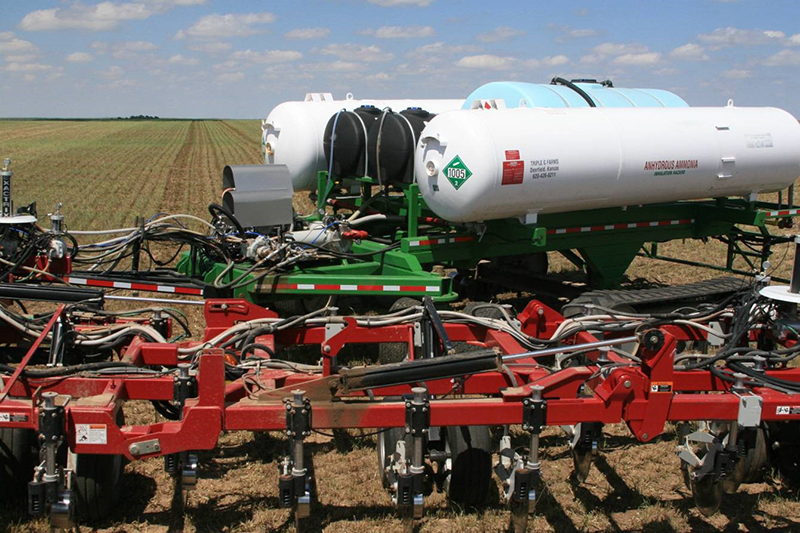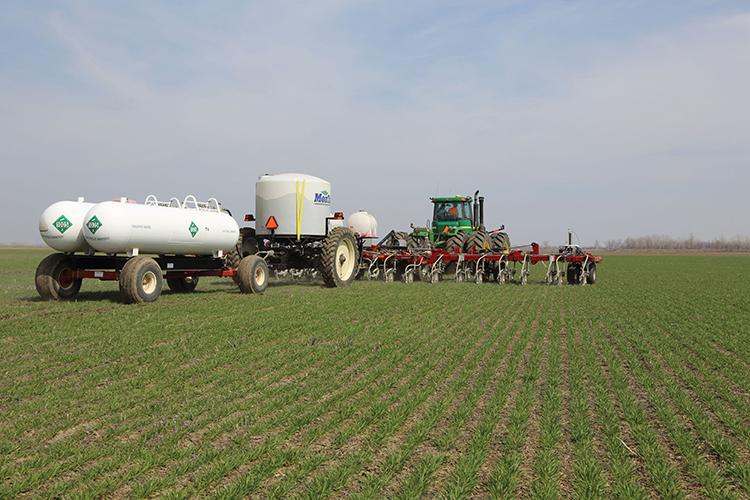|
Return To Main Page
Carbon emissions from fertilizers could be reduced by as much as 80% by 2050.
From Guy J Swanson, Feb. 14, 2023 The loss of fertilizer into the environment is the fertilizer industry short cut….to cover as many acres as possible at high and wasteful rates. This is mainly because the check writer or the producer has poor understanding of how fertilizer works. The University system must also take ownership of the problem. The closure of the fertilizer efficiency regulators in Muscle Shoals, Alabama allows the fertilizer organizations to treat crop producers like lemmings. Only about 10% of all crop producers really understand how fertilizer enters through the plant root system.
The Solution. No more shortcuts….do it the way the engineers designed it initially, circa the TVA, with deep banding of all nutrients. It will take more time….and rates can be reduced 50%. Educate Up, The Poorly educated fertilizer dealers that are manipulated by the inventory of the four Oligarch fertilizer manufacturers create problems for the environment. Poor education. Under current conditions fertilizer manufacturers have a very weak link to society and their customer. This factor alone allows Exactrix to deliver $150 more net income in irrigated conditions.
No management penalty is allowed.
Raising Winter Wheat Profits and Quality with
Anhydrous Ammonia. The environment on this river flood plain is enhanced
when nutrients are not surface applied. Duck Hunters appreciate a good
No-tillage field. A No-tillage February application of TAPPKTS plus Zinc
Bands set into the soil at 8-inch depths. The Mustang Bands applied
without tillage into growing winter wheat of the Missouri River Flood
Plain. A good way to grow a profitable crop year after year...well below the levee of the Missouri River, nutrients must be placed. Environmental conditions require a quality application with no loss to the rivers and streams. Pre-plant or side dress applications…the lowest cost fertilizer results in highest efficiency. The balanced TAPPKTS plus Zinc Exactrix product must be banded. The problem is not the fertilizer….the problem is the application and the education. FEBRUARY 9, 2023
Carbon emissions from
fertilizers could be reduced by as much as 80% by 2050.
Researchers have calculated the carbon footprint for the full life cycle of fertilizers, which are responsible for approximately 5% of total greenhouse gas emissions—the first time this has been accurately quantified—and found that carbon emissions could be reduced to one-fifth of current levels by 2050. The researchers, from the University of Cambridge, found that two thirds of emissions from fertilizers take place after they are spread on fields, with one third of emissions coming from production processes. Although nitrogen-based fertilizers are already known to be a major source of greenhouse gas emissions, this is the first time that their overall contribution, from production to deployment, has been fully quantified. Their analysis found that manure and synthetic fertilizers emit the equivalent of 2.6 gigatons of carbon per year—more than global aviation and shipping combined. Carbon emissions from fertilizers urgently need to be reduced; however, this must be balanced against the need for global food security. Earlier research has estimated that 48% of the global population are fed with crops grown with synthetic fertilizers, and the world's population is expected to grow by 20% until 2050. The Cambridge researchers say that a combination of scalable technological and policy solutions are needed to reduce fertilizer emissions while maintaining food security. However, they estimate that if such solutions could be implemented at scale, the emissions from manure and synthetic fertilizers could be reduced by as much as 80%, to one-fifth of current levels, without a loss of productivity. Their results are reported in the journal Nature Food. "Incredibly, we don't actually know how many chemicals we produce globally, where they end up, where and how they accumulate, how many emissions they produce, and how much waste they generate," said co-author Dr. André Cabrera Serrenho from Cambridge's Department of Engineering. Serrenho and his co-author Yunhu Gao undertook a project to accurately measure the total impacts of fertilizers, one of the two main products of the petrochemical industry. Of all the products made by the petrochemical industry, the vast majority—as much as 74%—are either plastics or fertilizers. "In order to reduce emissions, it's important for us to identify and prioritize any interventions we can make to make fertilizers less harmful to the environment," said Serrenho. "But if we're going to do that, we first need to have a clear picture of the whole lifecycle of these products. It sounds obvious, but we actually know very little about these things." The researchers mapped the global flows of manure and synthetic fertilizers and their emissions for 2019, along all stages of the lifecycle, by reconciling the production and consumption of nitrogen fertilizers and regional emission factors across nine world regions. After completing their analysis, the researchers found that unlike many other products, the majority of emissions for fertilizers occur not during production, but during their use. "It was surprising that this was the major source of emissions," said Serrenho. "But only after quantifying all emissions, at every point of the lifecycle, can we then start looking at different mitigation methods to reduce emissions without a loss of productivity." The researchers listed and quantified the maximum theoretical impact of different mitigation methods—most of these are already known, but their maximum potential effect had not been quantified. Emissions from the production of synthetic fertilizers are mostly from ammonia synthesis, partly due to chemical reactions used in the production process. The most effective mitigation at the production stage would be for the industry to decarbonize heating and hydrogen production. Additionally, fertilizers could be mixed with chemicals called nitrification inhibitors, which prevent bacteria from forming nitrous oxide. However, these chemicals are likely to make fertilizers more expensive. "If we're going to make fertilizers more expensive, then there needs to be some sort of financial incentive to farmers and to fertilizer companies," said Serrenho. "Farming is an incredibly tough business as it is, and farmers aren't currently rewarded for producing lower emissions." The single most effective way to reduce fertilizer-associated emissions, however, would be to reduce the amount of fertilizers that we use. "We're incredibly inefficient in our use of fertilizers," said Serrenho. "We're using far more than we need, which is economically inefficient and that's down to farming practices. If we used fertilizer more efficiently, we would need substantially less fertilizer, which would reduce emissions without affecting crop productivity." The researchers also looked at the mix of fertilizers used around the world, which varies by region. The researchers say that replacing some of the fertilizers with the highest emissions, such as urea, with ammonium nitrate worldwide could further reduce emissions by between 20% and 30%. However, this would only be beneficial after decarbonizing the fertilizer industry. "There are no perfect solutions," said Serrenho. "We need to rethink how we produce food, and what sorts of economic incentives work best. Perhaps that means paying farmers to produce fewer emissions, perhaps that means paying more for food. We need to find the right mix of financial, technological and policy solutions to reduce emissions while keeping the world fed." Serrenho and Gao estimate that by implementing all the mitigations they analyzed, emissions from the fertilizer sector could be reduced by as much as 80% by 2050. "Our work gives us a good idea of what's technically possible, what's big, and where interventions would be meaningful—it's important that we aim interventions at what matters the most, in order to make fast and meaningful progress in reducing emissions," said Serrenho. The research was part of the C-THRU project, led by Professor Jonathan Cullen, where researchers from four U.K. and U.S. universities are working to bring clarity to the emissions from the global petrochemical supply chain. More information: André Serrenho, Greenhouse gas emissions from nitrogen fertilizers could be reduced by up to one-fifth of current levels by 2050 with combined interventions, Nature Food (2023). DOI: 10.1038/s43016-023-00698-w. www.nature.com/articles/s43016-023-00698-w Journal information: Nature Food Provided by University of Cambridge
|





